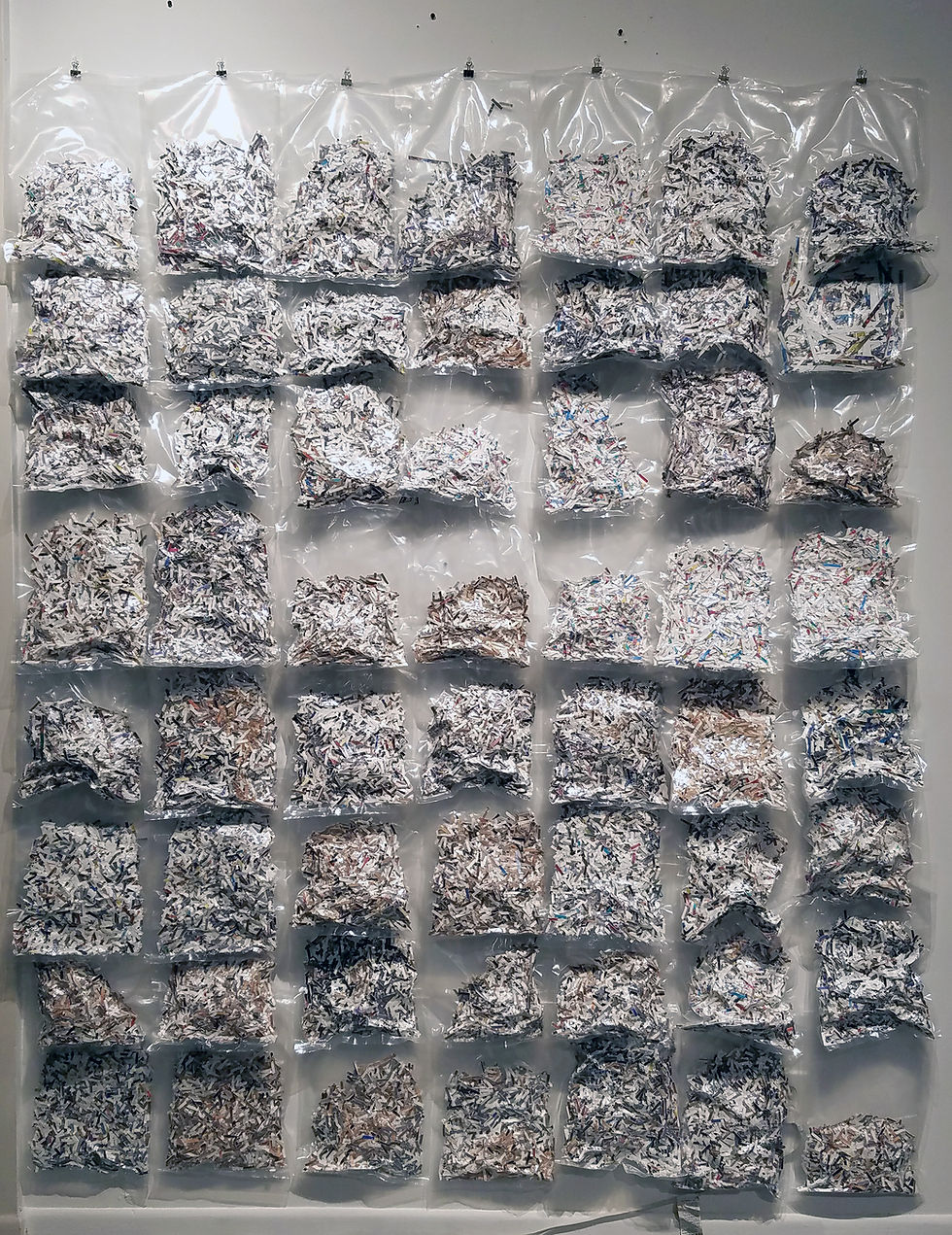Why I Keep Doing the Same Thing Over and Over (And Why That's the Point)
- Kristine Schomaker
- Jul 31
- 4 min read
I've been thinking about repetition in my work. Like, a lot. Because when I look at everything I've made over the past few years, there's this thread running through it all—I keep doing things over and over and over again.
Daily selfies for Face/Love. Hundreds of Zoom freeze-frame disasters. Jars filled with cut-up paintings. Grids of shredded photographs. Even my cutting practice itself—slice, slice, slice, repeat.
Someone asked me recently why I do this. Why the same thing again and again? And honestly, I think it took me a while to understand it myself.

The Women Who Got It First
I keep going back to Eleanor Antin's work, especially "Carving: A Traditional Sculpture" from 1972¹. She photographed her naked body every single day for 45 days while she was dieting. Same pose, same angle, same brutal documentation of what we do to ourselves in the name of being "better."
When I first saw this work, I felt it in my gut. This is what it looks like to make the invisible visible. This is what it means to document the violence we inflict on our own bodies, one day at a time.
Mary Kelly did something similar with "Post-Partum Document"²—six years of obsessive documentation of motherhood. Diaper prints, feeding schedules, her son's first words. She took all the invisible labor that women do and said: this matters enough to put in a museum.
And Agnes Martin with her thousands of hand-drawn lines³. The same gesture, over and over, for decades. I think about her sitting in her studio, drawing line after line, and how that repetition became a way of being present in time instead of trying to escape it.
Cindy Sherman's endless self-portraits⁴ showed me something else—that identity is always performed, always constructed. Every photo reveals a different version of "self." The repetition exposes the performance.
What My Repetitions Actually Do
But here's what I've realized about my own repetitive practice: it's not just about time or documentation (though it's definitely those things). It's about creating undeniable evidence.
When I take one selfie showing my crossed eyes, my double chin, my aging face—that can be dismissed. "Oh, bad angle." "Caught her on a bad day." "If she just tried harder..."
But when I take hundreds of selfies over months and years? When I create grids and archives and overwhelming visual proof that this is what I look like, this is how I age, this is my body refusing to apologize for existing? That becomes harder to dismiss.
The repetition creates weight. Literally—the accumulative weight of evidence that cannot be ignored.

Making Space Through Accumulation
My jars of cut-up art work the same way. Each piece of shredded canvas, each fragment of a destroyed painting, each snippet of a photograph I couldn't bear to look at anymore—they're all evidence of transformation in progress.
I used to think cutting up my art was about destruction. But filling jar after jar with the pieces, I realized it's about documentation. Every fragment is a decision I made about what to keep and what to let go of. Every jar is proof that change is possible, that we can survive the dismantling of who we used to be.
The repetitive act of cutting becomes meditation. The accumulation of fragments becomes hope.

The Marketing Thing (But Make It Art)
Okay, this might sound weird, but working with Art and Cake magazine taught me something about repetition that I think applies to my art practice too. In marketing, you repeat something until it sticks. Until it becomes impossible to ignore.
My artistic repetitions work similarly. I'm not just making art—I'm making sure the message gets through. That plus-size women's experiences matter. That aging faces deserve to be documented. That eating disorder recovery is a daily practice, not a destination.
One image might be overlooked. A hundred images become a statement. A thousand fragments become proof of survival.
What Actually Changes
Here's the thing about doing something over and over—it's never actually the same thing twice. Each Face/Love selfie captures a slightly different expression, a different light, a different moment in time. Each cut into a painting reveals something new underneath.
The repetition creates space for variation. For the small changes that mark healing. For the moments of unexpected beauty that emerge when you stop trying to control the outcome.
This is what those pioneering women artists understood: repetition isn't about making identical things. It's about creating a methodology for making visible what society wants to keep invisible.

The Accumulation of Resistance
Against a culture that tells me to disappear, I appear again and again. Against messages that I should be ashamed of my body, I document it repeatedly. Against the idea that plus-size women don't matter, I create overwhelming evidence to the contrary.
Each repetition is a small act of rebellion. Each accumulated fragment is proof that I was here, that I struggled, that I survived, that I transformed.
The repetition continues because some truths are too important to say just once. Because some bodies have been ignored for too long. Because some stories need to be told over and over until finally, finally, someone listens.
¹ Eleanor Antin, "Carving: A Traditional Sculpture," 1972, https://www.lacma.org/art/exhibition/eleanor-antin-times-arrow
² Mary Kelly, "Post-Partum Document," 1973-79, https://www.marykellyartist.com/
³ Agnes Martin's work at MoMA: https://www.moma.org/artists/3787-agnes-martin
⁴ Cindy Sherman's photography: https://www.moma.org/artists/5392-cindy-sherman







Формат ФОП в Україні https://delo.ua/business/use-shho-potribno-znati-pro-fop-v-ukrayini-449790/ залишається популярним - це зручний варіант для малого бізнесу. Реєстрація проста. Можна оформити через «Дію» без черг. Доступна спрощена звітність. Є порядок із податками. Мінімальний ЄСВ у 2025 році — 1760 грн щомісяця. Розмір єдиного податку залежить від групи. Є чотири групи. Перша — найменше навантаження. Друга — до 10 працівників. Третя — працювати з юрособами. Четверта — аграрії. Платників єдиного податку звільняють від ПДВ. Але ЄСВ — обов’язковий. Також потрібно врахувати витрати на облік, інструменти, рекламу й юридичну підтримку